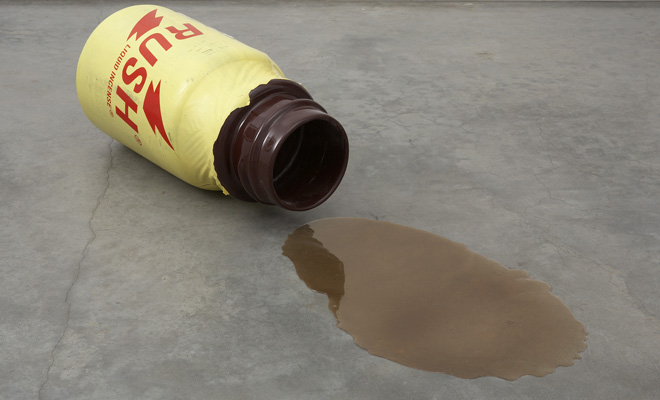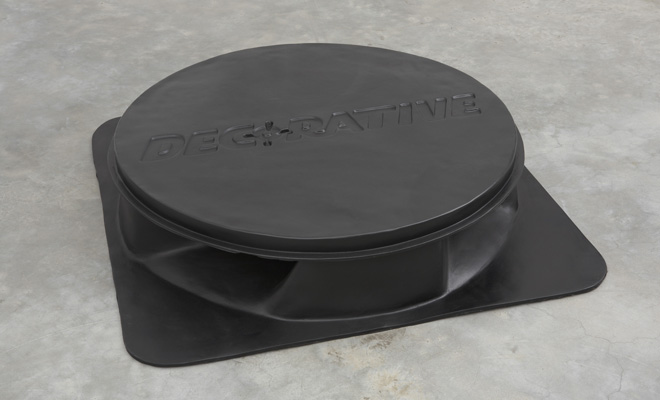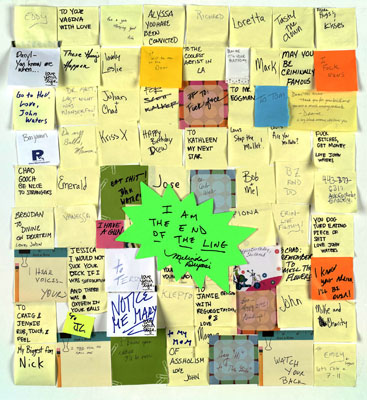Review: John Waters: “Catholic Sin”

John Waters, Rush, 2009. Polyurethane, oil, and PVC plastic. Courtesy the artist and Arthur Roger Gallery, New Orleans.
Editor's Note
As curator of Scumbag Cinema, Wesley Stokes screens John Waters’ Desperate Living (1977) tonight, October 26, at 9 pm at Antenna Gallery. For the occasion, Pelican Bomb asked Stokes to also weigh in on Waters’ exhibition at Arthur Roger Gallery on view until October 29.
In the midst of so much discussion about Prospect.2, John Waters’ “Catholic Sin” was arguably the most talked about highlight from Art for Arts’ Sake just a few weeks prior, mainly because Waters himself showed up to the opening. The exhibition would have garnered attention solely based on its namesake but an appearance by the Pope of Filth definitely lent agency to the work.
Since the mid ’60s, Waters has made some of the most shocking and influential trashy films in cinematic history. For years he dodged mainstream success, angering critics and religious family groups with dog-shit-eating drag queens and torturous babysitters before slowly grabbing the attention of a wider audience with films such as Crybaby and Hairspray (later adapted into a successful on- and off-Broadway play). In the following decades, he managed to situate himself beyond the subculture of weirdos and freaks that first adored him to the status of a respected contributor to The New Yorker and Artforum, as well as a celebrated author with last year’s release of his book Role Models. It would be petty to hold this alliance with the types of institutions that spent so many years snubbing Waters against him, and while he may have found an artistic loophole and well-deserved income for so much time and work as an auteur of trash, one can’t help but feel kind of disappointed.
“Catholic Sin” is in part a collection of photographs taken from Waters’ own television screen and positioned together to form comic-strip-like narratives or altered to create ridiculous compendiums. Look Out!, 2009, depicts three black-and-white films aligned with the same outcome—a frightened femme speeding to her ultimate demise in seven frames. It begins with the look of horror, followed by the inability to brake, and ends in the wreck of her automobile. It’s reminiscent of Andy Warhol’s Death and Disaster series, but the difference in Waters’ sensibility and Warhol’s is the apparent humor. Warhol’s pictures were sourced from real incidents and then turned into art while Waters’ pictures are taken from Hollywood films and somehow made “real” by being positioned as fine art. Waters’ re-imagining of an existing fiction breaks it down literally frame-by-frame, exaggerating the drama and the relationship between cause and effect. Still the piece has more in common with Jayne Mansfield morbidity fandom than Andy Warhol—the work of an acolyte of pop culture rather than the work of one who defines it.

John Waters, Decorative, 2009. Fiberglass and oil. Courtesy the artist and Arthur Roger Gallery, New Orleans.
On the floor, a fiberglass sculpture of an oversized roach trap has the word “DECORATIVE” inscribed across it in place of the Combat logo. Similarly, Le Mer, 2009, is a monumental jar of the high-priced moisturizing cream and Rush, 2009, a giant spilt bottle of liquid incense, a tribute to Waters’ disco days when it was inhaled widely as a club and sex drug. The works seem more Waters covering the work of Claes Oldenburg (Urs Fischer also comes to mind) than anything but are nevertheless funny in the vein of classic gags. A whoopee cushion is inherently funny because everyone knows what a whoopee cushion does, thus a giant whoopee cushion might be even funnier.
The work that is most telling of Waters’ awareness of his own celebrity is probably Stalker, 2009, a print that features a bulletin board covered in post-it notes written obsessively in Sharpie and often with the kind of catty, crude referents John Waters is known for. A few examples read: “I KNOW YOUR ADDRESS. I’LL BE OVER!,” “MAY YOU BE CRIMINALLY FAMOUS,” and “YOU DOG TURD EATING PIECE OF SHIT LOVE JOHN WATERS.” The piece works because of who Waters is and the sort of cult following that surrounds him. Obsessive fan paraphernalia, as though it were sourced for inspiration, makes it seem as if Waters feeds on the filthy energy he's exuded. That being said, the power of the show is that it’s got John Waters’ name stamped on it, otherwise it would be just a whisper in the wind forgotten after a month or two. I hope Mr. Waters takes any money made on this show and makes a much-needed nasty, low-brow movie that takes a huge dump on the summer action movies and rom-coms that fill up over-priced chain theaters. Maybe he'll even make it in 3D.

John Waters, Stalker, 2009. C-print. Courtesy the artist and Arthur Roger Gallery, New Orleans.



